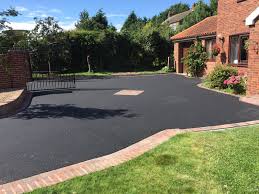Why Winter Maintenance Matters
The Impact of Cold Weather on Driveways
As winter approaches, most homeowners focus on their heating systems, windows, and roofs. But what about the driveway? It’s one of the most exposed areas of your property and endures some of the harshest conditions—snow, ice, freezing temperatures, and the weight of your vehicle.
Cold weather can wreak havoc on your driveway. When temperatures fluctuate, water seeps into small cracks and expands as it freezes. This freeze-thaw cycle can widen cracks, create potholes, and cause significant damage to the structural integrity of your driveway. Add in snowplows, de-icing chemicals, and parked cars, and it’s easy to see why preparation is essential.
Neglecting your driveway in winter not only results in an eyesore but also in costly repairs come spring. A few hours of seasonal prep can save you hundreds—or even thousands—down the road.
Common Winter Damages to Driveways
Winter isn’t just a cosmetic threat to your driveway. Here are the most common issues to watch out for:
- Cracking and expansion damage
- Surface erosion from salt and chemicals
- Water pooling leading to frost heave
- Oil or fluid leaks freezing into the surface
- Increased wear from snow shovels and plows
Each of these issues not only shortens the lifespan of your driveway but also affects safety. Slippery or uneven surfaces can lead to falls and injuries, especially in icy conditions. That’s why proactive maintenance is more than just smart—it’s necessary.
Assessing Your Driveway’s Current Condition
Inspect for Cracks and Potholes
Start your winter prep with a visual inspection. Walk your driveway and take note of any visible cracks, potholes, or crumbling edges. Use a marker or chalk to highlight problem areas for repair.
Small cracks may seem harmless, but during winter, they act as entry points for water. Once inside, that water freezes and expands, turning a hairline fracture into a large crack or hole. The sooner you patch these up, the better your driveway will withstand the cold.
If you notice significant damage, it’s wise to consult a professional for advice on whether repairs or a full resurface is needed.
Drainage Check: Is Water Pooling?
Water is your driveway’s biggest enemy during winter. After rainfall or snowmelt, observe if water collects in certain areas. These “ponds” indicate poor drainage and are likely spots for ice buildup and frost heave.
Proper drainage systems—like sloped surfaces, French drains, or catch basins—ensure water flows away from your driveway. Fixing drainage issues now can prevent dangerous ice slicks and long-term structural damage.
Surface Wear and Sealant Condition
If your driveway has been sealed previously, check the surface for signs of wear. Is the surface dull, flaking, or discolored? These are signs your sealant has broken down and needs reapplication.
A good sealant acts as a barrier, protecting your driveway from water, chemicals, and UV rays. Reapplying before winter can save your surface from significant wear during the colder months.
Cleaning Your Driveway Before Winter
Removing Debris and Organic Matter
Leaves, sticks, dirt, and other debris may seem harmless, but they trap moisture against your driveway’s surface. When temperatures drop, that moisture freezes and leads to damage.
Sweep your driveway thoroughly. Pay special attention to edges and corners where debris tends to accumulate. If you have trees nearby, consider installing barriers or regularly raking to prevent buildup.
Power Washing for Deep Cleaning
For a truly clean surface, power washing is a must. It removes ground-in dirt, oil stains, moss, and mildew—all of which can weaken your driveway’s surface if left untreated.
Power washing before sealing also ensures the sealant adheres properly. Be cautious with the pressure setting; too much force can damage older or brittle surfaces.
Clearing Gutters and Edges
Clean gutters help channel water away from your driveway. Blocked gutters often lead to overflow, which pools on your driveway and eventually freezes. This can create icy patches and hasten surface wear.
Trim back any overhanging shrubs or grass along the driveway’s edge as well. Overgrowth can obstruct water flow and trap snow, leading to faster freeze cycles.
Repair and Seal
Filling Cracks and Patching Holes
Now’s the time to patch those cracks and holes you marked earlier. Use concrete or asphalt patch products for minor repairs. For tarmac surfaces, make sure to choose a compatible filler.
Apply filler according to the manufacturer’s instructions and give it ample time to dry and cure. Doing this before temperatures drop below freezing is crucial—most repair products don’t bond properly in cold weather.
Reapplying Sealant
If your driveway hasn’t been sealed in the last 2–3 years, now is the perfect time. Choose a high-quality, weather-resistant sealant and apply it during dry weather with temperatures above 10°C (50°F).
A fresh layer of sealant will:
- Repel water and ice
- Resist salt and chemical erosion
- Prevent surface cracking
- Improve appearance
For homeowners with tarmac driveways Poole, sealing is especially important to maintain that smooth, jet-black finish and protect it from frost and UV exposure.
When to Hire a Professional
Some repairs and sealants are best left to the pros—especially for larger driveways or heavily damaged surfaces. Professionals have access to commercial-grade products, proper tools, and the experience to ensure the job is done right the first time.
Whether you’re dealing with large cracks, surface crumbling, or drainage issues, hiring a specialist can save you time and frustration while ensuring your driveway is winter-ready.

